Project B theme by B.Zero.One
Download: ProjectB.p3t
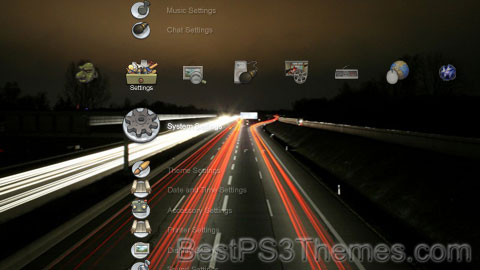
(1 background)

The #1 spot for Playstation themes!
Ghost Rider theme by Julian
Download: GhostRider.p3t
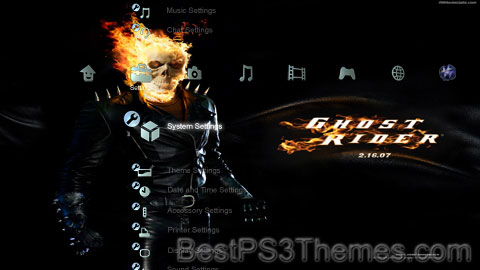
(2 backgrounds)
| Ghost Rider | |
|---|---|
 Ghost Rider on the cover of Marvel Spotlight #5 (Aug. 1972). | |
| Publication information | |
| Publisher | Marvel Comics |
| First appearance | Marvel Spotlight #5 (August 1972) |
| Created by | |
| In-story information | |
| Alter ego |
|
| Species | Human/demon hybrid |
| Team affiliations |
|
| Notable aliases |
|
| Abilities |
|
Ghost Rider is the name of multiple superheroes or antiheroes appearing in American comic books published by Marvel Comics. Marvel had previously used the name for a Western character whose name was later changed to Phantom Rider.
The first supernatural Ghost Rider is stunt motorcyclist Johnny Blaze, who sold his soul, to save the life of his foster father, agrees to give his soul to "Satan" (later revealed to be an arch-demon named Mephisto). At night and when around evil, Blaze finds his flesh consumed by hellfire, causing his head to become a flaming skull. He rides a fiery motorcycle and wields blasts of hellfire from his body, usually from his skeletal hands. He eventually learns he has been bonded with the demon Zarathos. Blaze is featured in the series Ghost Rider (vol. 2) from 1972 to 1983.
The subsequent Ghost Rider series (1990–1998) features Danny Ketch as a new Ghost Rider. After his sister was injured by ninja gangsters, Ketch comes in contact with a motorcycle that contains the essence of a Spirit of Vengeance. Blaze reappears in this 1990s series as a supporting character, and it is later revealed that Danny and his sister were Johnny Blaze's long-lost siblings. In 2000s comics, Blaze succeeds Ketch, becoming Ghost Rider again. In 2014, Robbie Reyes becomes Ghost Rider as part of the Marvel NOW! initiative.
In May 2011, Ghost Rider placed 90th on IGN's "Top 100 Comic Book Heroes" list.[1] Nicolas Cage starred as the Johnny Blaze incarnation of the character in the 2007 film Ghost Rider and its 2012 sequel, Ghost Rider: Spirit of Vengeance. Gabriel Luna and Tom McComas portray the Robbie Reyes and Johnny Blaze incarnations in the fourth season of the Marvel Cinematic Universe (MCU) television series Agents of S.H.I.E.L.D., with Henry Simmons and Clark Gregg portraying original incarnations Alphonso Mackenzie and Phil Coulson.
Following the Western comics character who originally used the name, the first superhero Ghost Rider, Johnny Blaze, debuted in Marvel Spotlight issue #5 (Aug. 1972), created by Marvel editor-in-chief Roy Thomas,[2] writer Gary Friedrich and artist Mike Ploog. He received his own series in 1973, with penciller Jim Mooney handling most of the first nine issues. Several different creative teams mixed-and-matched until penciller Don Perlin began a considerably long stint with issue #26, eventually joined by writer Michael Fleisher through issue #58. The series ran through issue #81 (June 1983). Blaze returned as Ghost Rider in a 2001 six-issue miniseries written by Devin Grayson; a second miniseries written by Garth Ennis in 2005, and an ongoing monthly series that began publication in July 2006. Johnny Blaze was the son of Naomi Blaze and Barton Blaze. Naomi was the previous Ghost Rider.
The next Ghost Rider, a young man named Daniel "Danny" Ketch (Johnny Blaze's long-lost younger brother), debuted in Ghost Rider (vol. 3) #1 (May 1990). This Ghost Rider was nearly identical to the previous, although his costume was now a black leather biker jacket with spiked shoulder-pads, grey leather pants, and a mystic chain he wore across his chest, which responded to his mental commands and served as his primary melee weapon. His new motorcycle resembled a futuristic machine and the front of it could lower to serve as a battering ram. Like the original Ghost Rider's bike, the wheels were composed of mystic hellfire. Unlike the relationship between the previous Ghost Rider and the demon with which he was bonded, Ketch and his demon — who in (vol. 3) #91 (Dec. 1997) is revealed to be Marvel's incarnation of the Angel of Death/Judgment — are cooperative with each other. At the close of the series with (vol. 3) #93 (Feb. 1998), Ketch apparently died. The following year, however, Peter Parker: Spider-Man #93 (July 1999) revealed Ketch was still alive. Nearly a decade later, Marvel published the long-completed final issue as Ghost Rider Finale (Jan. 2007), which reprints the last issue and the previously unpublished Ghost Rider (vol. 3) #94.[3]
During the 2011 storyline "Fear Itself", a Nicaraguan woman named Alejandra Jones becomes Ghost Rider through a ritual performed by a man named Adam. Though she demonstrates many previously unknown powers of the Ghost Rider entity, she is deprived of its full power when Johnny Blaze takes back most of this power in (Vol. 7) #9. She was killed by Carnage during the Absolute Carnage event.
In 2014, a new character took on the Ghost Rider mantle: a Mexican-American resident of East Los Angeles named Roberto "Robbie" Reyes, who drives a black classic muscle car reminiscent of a modified 1969 Dodge Charger rather than a motorcycle.[4][5] Robbie Reyes was created by writer/artist Felipe Smith and designed by Smith and artist Tradd Moore.[6]
Michael Badilino, an ex-member of the New York City Police Department, is one-third of an "Organic Medallion of Power"; the other two are Ketch and Blaze (the Medallion itself was never explained in any true detail). He possesses powers more in line with those of the Zarathos version of Ghost Rider, although he also possesses the Penance Stare and his motorcycle seemed to share characteristics with the Noble Kale version. His appearance is distinguished by a deep purple skull, large fangs protruding from his upper jaw, and backswept curved horns on the top of his skull.
In his superhuman form, Badilino was called Vengeance, and originally attempted to kill the Ghost Rider, believing him to be Zarathos. Vengeance later became the ally of Ghost Rider and Johnny Blaze. Vengeance also took on the role of the Ghost Rider and even semi-seriously referred to himself by that name when confronted by Spider-Man shortly after the apparent death of Ghost Rider in battle with Zarathos and acolytes The Fallen. Vengeance killed himself, along with the villain Hellgate, by triggering a massive explosion through his Hellfire, the source of the mystical flames that encompass the bones of both Vengeance and Ghost Rider.
Vengeance reappears in the last four issues of Ghost Rider (vol. 3), involved in Blackheart's plans to kill Noble Kale. Vengeance aids the Ghost Rider in the ensuing battle, destroying Blackheart and ruling Hell during Ketch's absences.
In the 19th century, while her tribe was being attacked by the U.S. Army, Kushala's parents were killed and, in an act of rage, she prayed to her creator, but instead was possessed by a Spirit of Vengeance. Then she burnt everyone until all that remained were their spirits. After becoming possessed by the Spirit of Vengeance, Kushala traveled the world seeking out and studying different forms of magic in an attempt to cure herself. Her skills in the mystic arts eventually led to her becoming the Sorcerer Supreme of her era.
The Ghost Rider is a human who can transform into a skeletal superhuman wreathed in ethereal flame and given supernatural powers. The abnormal motorcycle he rides can travel faster than any conventional vehicle and perform impossible feats such as riding up a vertical surface, across water, and leaping across great distances that normal motorcycles cannot. The Ghost Riders are virtually indestructible and notoriously hard to injure by any conventional means, as bullets and knives usually pass through them without causing pain (knives are shown to melt while in their body).[7] It is possible that they are genuinely immortal, as it is said that God created them and only God can destroy them.[8] Despite being composed of bone and hellfire, the Ghost Riders possess formidable superhuman strength, enough to easily pick up a truck and hurl it across a road. It has been stated that Johnny Blaze as Ghost Rider can bench press around 25 tons (50,000 lbs) (or more as seen in World War Hulk).[9] Each Ghost Rider entity also had abilities specific to him or her.
Naomi Kale is the mother of Johnny Blaze, Danny Ketch, and Barbara Ketch.
Noble lived in the 18th century and grew up with his abusive father Pastor Kale and his younger brother Dante.
Noble fell in love with a black girl named Magdelena. But, because of the color of her skin and his father's strong religious views, the couple kept their love a secret from the world. They were forced to tell Pastor Kale when Magdelena bore Noble's child. Noble and Magdelena were then married.
Shortly after the marriage, Magdelena discovered Pastor Kale's dark secret; he was a servant of the dark lord Mephisto. To cover up Magdelena's findings, Pastor Kale accused her of witchcraft and had her burned at the stake. Knowing that his son, Noble, would object, he had him drugged, tortured and beaten in the church cellar.
Just before Magdelena died, she used a curse to summon demons that avenge wronged women. The demons were called "Furies" and they started killing the townspeople. Fearing death, Pastor Kale struck a deal with Mephisto. In return for his safety, Mephisto got Noble's soul. Mephisto realized that Noble was attached to a piece of the Medallion of Power and he activated the piece to transform Noble into the original "Spirit of Vengeance". When Ghost Rider had destroyed the Furies, Pastor offered him human flesh - Noble's son. Noble, in the guise of Ghost Rider, was unwilling to eat his own child and he killed himself.
When Mephisto later appeared to claim Noble's soul, Mephisto's brother, the archangel Uriel, appeared and demanded that the soul of Noble Kale be spared. No agreement could be reached, and therefore a compromise was made whereby Noble's soul could not be claimed by either realm; but instead, his soul would remain in the void until re-bonded with certain members of his family.[13]
Noble Kale was also established as an ancestor of Jennifer Kale.[14]
Due to the Celestial Progenitor presence influencing human evolution, in 1,000,000 B.C., certain humans became much more intelligent than others as well as able to speak a new language. However, they had to hide that gift from their brethren for fear of being ostracized. One day, a boy that was gifted with the ability to speak is approached by a mysterious stranger that also possessed that gift, only to witness the stranger transform into a beast and devour his entire tribe. The stranger allowed the boy to live and names him "Ghost" before telling him to challenge him when he is worthy. The boy was forced to survive on his own, though he does befriend a woolly mammoth. After almost dying in the harsh environment, he is approached by Mephisto in the form of a snake, who tells him to say its name. Ghost does that and is bonded with a Spirit of Vengeance; after which he imbued his newly acquired hellfire into the mammoth. Other humans had never seen someone ride an animal before and began referring to Ghost as "the Rider". The Rider continued his search and five years later, eventually caught up with the man who devoured his tribe. The man transformed once more, revealing himself to be the first Wendigo. During the fight, the Rider took the bones of the dead that the Wendigo had killed and used them to form a weapon; the earliest version of the Ghost Rider's signature chain. The Rider fought the Wendigo until finally it and the Rider's woolly mammoth tumbled over a cliff. Afterwards, Ghost was approached by Odin and Lady Phoenix to join the prehistoric version of the Avengers.[15]
Upon imbuing his hellfire into another woolly mammoth, the Ghost Rider assisted the prehistoric Avengers (consisting of Agamotto, Odin, Lady Phoenix, and prehistoric versions of the Black Panther, Iron Fist, and Star Brand) in fighting an out of control Celestial called the Fallen; which resulted in his woolly mammoth getting killed in action. The Ghost Rider swore revenge and assisted his teammates in defeating the Fallen and sealing it away underground in what would become South Africa.[11] The Ghost Rider later assisted the prehistoric Avengers in fighting the First Host.[16]
During the 11th century, a Native American chieftain from the Sioux nation named Hellhawk sported the powers of the Ghost Rider. He was part of Thor's Avengers of 1,000 A.D.[17][18]
During the 17th century, Hellhawk developed a rivalry with Noble Kane.[19] He was later killed by Narcosis to serve as a warning to Mephisto by Belasco to keep his Spirits of Vengeance out of Limbo.[20]
Seven riders show their flaming heads for the first time in this story arc by writer Jason Aaron and artist Tan Eng Huat. Daniel Ketch returns with a new mission: to collect the powers of all the Ghost Riders for the angel Zadkiel to prevent the corruption of the powers with their human hosts. Zadkiel has other motives he keeps to himself, for which he needs the powers of the riders to tear down the walls of New Jerusalem and wage war on the heavens.
A version of Ghost Rider appeared in the miniseries Ghost Rider: Trail of Tears #1–6 (April–Sept. 2007) by writer Garth Ennis and artist Clayton Crain. Set during the American Civil War, it finds Confederate officer Travis Parham avenging the murders of his friend, an ex-slave named Caleb and Caleb's family. Parham meets a horse-riding Ghost Rider who seeks the same men. Eventually, Parham learns about the deaths instrumental in helping set forth the Spirit of Vengeance.
During the 19th century, an unnamed Ghost Rider was active during the American frontier. He targeted anyone who killed Native American women and children or who cut off their scalps.[19]
Deputy Kowalski was a normal cop in a small town until Ghost Rider rode in one day. It was then that Kowalski was kidnapped by a local cannibal who cut off his hand. Events transpired that led to Kowalski escaping and developing a wrath against the Ghost Rider. His attention was brought to the hellfire shotgun in possession of Badilino. After purchasing the gun—and discovering to Badilino's surprise that it will work for Kowalski—Kowalski was recruited by agents of Zadkiel and told to wait in the middle of the desert for the Ghost Rider. Johnny Blaze (as Ghost Rider) did arrive in hot pursuit of Danny Ketch (as a new incarnation of Ghost Rider). Kowalski did manage to get a shot in on Blaze. Although it was a minor setback Blaze resumed his pursuit of Ketch. Left in the desert Kowalski soon found himself transformed into the new Vengeance, sporting green flames and a hook for his right hand, after Ketch returned the powers of the Spirits of Vengeance to Earth.[volume & issue needed]
With a thirst for revenge, Kowalski, as Vengeance, was recruited by Blackout as a member of Zadkiel's Ghost Rider Assassination League.[21] Kowalski was partnered with The Orb and was to stop Blaze and Ketch from reaching a monastery which contained a gateway to Heaven. Kowalski was easily defeated by both Ghost Riders and was left as a pet with the monastery's Mother Superior.[22]
Vengeance was later freed by the Shadow Council and joins the ninth incarnation of the Masters of Evil.[23]
Captain America theme by Julian
Download: CaptainAmerica.p3t
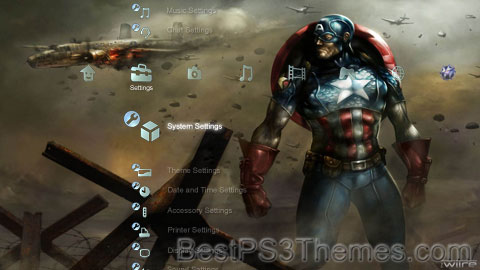
(1 background)
| Steve Rogers Captain America | |
|---|---|
 | |
| Publication information | |
| Publisher | Marvel Comics[a] |
| First appearance | Captain America Comics #1 (December 20, 1940)[b] |
| Created by | Joe Simon Jack Kirby |
| In-story information | |
| Full name | Steven Rogers |
| Place of origin | New York City |
| Team affiliations | |
| Partnerships | |
| Notable aliases | Nomad, The Captain |
| Abilities |
|
Captain America is a superhero created by Joe Simon and Jack Kirby who appears in American comic books published by Marvel Comics. The character first appeared in Captain America Comics #1, published on December 20, 1940, by Timely Comics, a corporate predecessor to Marvel. Captain America's civilian identity is Steve Rogers, a frail man enhanced to the peak of human physical perfection by an experimental "super-soldier serum" after joining the United States Army to aid the country's efforts in World War II. Equipped with an American flag–inspired costume and a virtually indestructible shield, Captain America and his sidekick Bucky Barnes clashed frequently with the villainous Red Skull and other members of the Axis powers. In the final days of the war, an accident left Captain America frozen in a state of suspended animation until he was revived in modern times. He resumes his exploits as a costumed hero and becomes leader of the superhero team the Avengers, but frequently struggles as a "man out of time" to adjust to the new era.
The character quickly emerged as Timely's most popular and commercially successful wartime creation upon his original publication, though the popularity of superheroes declined in the post-war period and Captain America Comics was discontinued in 1950. The character saw a short-lived revival in 1953 before returning to comics in 1964, and has since remained in continuous publication. Captain America's creation as an explicitly anti-Nazi figure was a deliberately political undertaking: Simon and Kirby were stridently opposed to the actions of Nazi Germany and supporters of U.S. intervention in World War II, with Simon conceiving of the character specifically in response to the American non-interventionism movement. Political messages have subsequently remained a defining feature of Captain America stories, with writers regularly using the character to comment on the state of American society and government.
Having appeared in more than ten thousand stories in more than five thousand media formats, Captain America is one of the most popular and recognized Marvel Comics characters, and has been described as an icon of American popular culture. Though Captain America was not the first United States–themed superhero, he would become the most popular and enduring of the many patriotic American superheroes created during World War II. Captain America was the first Marvel character to appear in a medium outside of comic books, in the 1944 serial film Captain America; the character has subsequently appeared in a variety of films and other media, including the Marvel Cinematic Universe, where he was portrayed by actor Chris Evans from the character's first appearance in Captain America: The First Avenger (2011) to his final appearance in Avengers: Endgame (2019).
"It was a time of deep passion. Hitler was grabbing all of Europe, we had Nazis in America, Nazis holding mass meetings in Madison Square Garden. [...] Captain America was created in that atmosphere, he was a natural outgrowth of the passionate mood of the country."
In 1940, Timely Comics publisher Martin Goodman responded to the growing popularity of superhero comics – particularly Superman at rival publisher National Comics Publications, the corporate predecessor to DC Comics – by hiring freelancer Joe Simon to create a new superhero for the company.[2] Simon began to develop the character by determining who their nemesis could be, noting that the most successful superheroes were defined by their relationship with a compelling villain, and eventually settled on Adolf Hitler.[3][4] He rationalized that Hitler was the "best villain of them all" as he was "hated by everyone in the free world",[4] and that it would be a unique approach for a superhero to face a real-life adversary rather than a fictional one.[3][c]
This approach was also intentionally political. Simon was stridently opposed to the actions of Nazi Germany and supported U.S. intervention in World War II, and intended the hero to be a response to the American non-interventionism movement.[5] Simon initially considered "Super American" for the hero's name, but felt there were already multiple comic book characters with "super" in their names.[6] He worked out the details of the character, who was eventually named "Captain America", after he completed sketches in consultation with Goodman.[2] The hero's civilian name "Steve Rogers" was derived from the telegraphy term "roger", meaning "message received".[2]
Goodman elected to launch Captain America with his own self-titled comic book, making him the first Timely character to debut with his own ongoing series without having first appeared in an anthology.[4] Simon sought to have Jack Kirby be the primary artist on the series: the two developed a working relationship and friendship in the late 1930s after working together at Fox Feature Syndicate, and had previously developed characters for Timely together.[7][8] Kirby also shared Simon's pro-intervention views, and was particularly drawn to the character in this regard.[4] Goodman, conversely, wanted a team of artists on the series. It was ultimately determined that Kirby would serve as penciller, with Al Avison and Al Gabriele assisting as inkers;[4] Simon additionally negotiated for himself and Kirby to receive 25 percent of the profits from the comic.[9] Simon regards Kirby as a co-creator of Captain America, stating that "if Kirby hadn't drawn it, it might not have been much of anything."[4]

Captain America Comics #1 was published on December 20, 1940,[10] with a cover date of March 1941.[11] While the front cover of the issue featured Captain America punching Hitler, the comic itself established the Red Skull as Captain America's primary adversary, and also introduced Bucky Barnes as Captain America's teenaged sidekick.[12] Simon stated that he personally regarded Captain America's origin story, in which the frail Steve Rogers becomes a supersoldier after receiving an experimental serum, as "the weakest part of the character", and that he and Kirby "didn't put too much thought into the origin. We just wanted to get to the action."[4] Kirby designed the series' action scenes with an emphasis on a sense of continuity across panels, saying that he "choreographed" the sequences as one would a ballet, with a focus on exaggerated character movement. Kirby's layouts in Captain America Comics are characterized by their distorted perspectives, irregularly shaped panels, and the heavy use of speed lines.[13]
The first issue of Captain America Comics sold out in a matter of days, and the second issue's print run was set at over one million copies.[14][15] Captain America quickly became Timely's most popular character, with the publisher creating an official Captain America fan club called the "Sentinels of Liberty".[5][d] Circulation figures remained close to a million copies per month after the debut issue, which outstripped even the circulation of news magazines such as Time during the same period.[17] Captain America Comics was additionally one of 189 periodicals that the US Department of War deemed appropriate to distribute to its soldiers without prior screening.[18] The character would also make appearances in several of Timely's other comic titles, including All Winners Comics, Marvel Mystery Comics, U.S.A. Comics, and All Select Comics.[19]
Though Captain America was not the first United States-themed superhero – a distinction that belongs to The Shield at MLJ Comics[20] – he would become the most popular patriotic American superhero of those created during World War II.[21] Captain America's popularity drew a complaint from MLJ that the character's triangular heater shield too closely resembled the chest symbol of The Shield. This prompted Goodman to direct Simon and Kirby to change the design beginning with Captain America Comics #2. The revised round shield went on to become an iconic element of the character;[20] its use as a discus-like throwing weapon originated in a short prose story in Captain America Comics #3, written by Stan Lee in his professional debut as a writer.[22][23] Timely's publication of Captain America Comics led the company to be targeted with threatening letters and phone calls from the German American Bund, an American Nazi organization. When members began loitering on the streets outside the company's office, police protection was posted and New York mayor Fiorello La Guardia personally contacted Simon and Kirby to guarantee the safety of the publisher's employees.[24]
Simon wrote the first two issues of Captain America Comics before becoming the editor for the series; they were the only Captain America stories he would ever directly write.[25] While Captain America generated acclaim and industry fame for Simon and Kirby, the pair believed that Goodman was withholding the promised percentage of profits for the series, prompting Simon to seek employment for himself and Kirby at National Comics Publications.[9] When Goodman learned of Simon and Kirby's intentions, he effectively fired them from Timely Comics, telling them they were to leave the company after they completed work on Captain America Comics #10.[26] The authorship of Captain America Comics was subsequently assumed by a variety of individuals, including Otto Binder, Bill Finger, and Manly Wade Wellman as writers, and Al Avison, Vince Alascia, and Syd Shores as pencilers.[16]
Superhero comics began to decline in popularity in the post-war period.[27] This prompted a variety of attempts to reposition Captain America, including having the character fight gangsters rather than wartime enemies in Captain America Comics #42 (October 1944), appearing as a high school teacher in Captain America Comics #59 (August 1946), and joining Timely's first superhero team, the All-Winners Squad, in All Winners Comics #19 (Fall 1946).[16] The series nevertheless continued to face dwindling sales, and Captain America Comics ended with its 75th issue in February 1950.[16] Horror comics were ascendant as a popular comic genre during this period; in keeping with the trend, the final two issues of Captain America Comics were published under the title Captain America's Weird Tales.[16]
Timely's corporate successor Atlas Comics relaunched the character in 1953 in Young Men #24, where Captain America appears alongside the wartime heroes Human Torch and Toro, which was followed by a revival of Captain America Comics in 1954 written by Stan Lee and drawn by John Romita.[28] In the spirit of the Cold War and McCarthyism, the character was billed as "Captain America, Commie Smasher" and faced enemies associated with the Soviet Union.[29] The series was a commercial failure, and was cancelled after just three issues.[29] Romita attributed the series' failure to the changing political climate, particularly the public opposition to the Korean War; the character subsequently fell out of active publication for nearly a decade, with Romita noting that "for a while, 'Captain America' was a dirty word".[30]
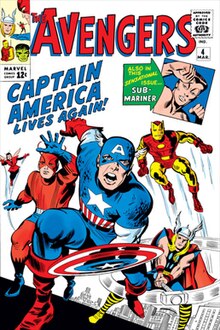
Captain America made his ostensible return in the anthology Strange Tales #114 (November 1963), published by Atlas' corporate successor Marvel Comics. In an 18-page story written by Lee and illustrated by Kirby,[e] Captain America reemerges following years of apparent retirement, though he is revealed as an impostor who is defeated by Johnny Storm of the Fantastic Four. A caption in the final panel indicates that the story was a "test" to gauge interest in a potential return for Captain America;[32] the reader response to the story was enthusiastic,[33] and the character was formally reintroduced in The Avengers #4 (March 1964).[34]
The Avengers #4 retroactively established that Captain America had fallen into the Atlantic Ocean in the final days of World War II, where he spent decades frozen in ice in a state of suspended animation before being found and recovered.[34][f] Captain America solo stories written by Lee with Kirby as the primary penciller were published in the anthology Tales of Suspense alongside solo stories focused on fellow Avengers member Iron Man beginning in November 1964; the character also appeared in Lee and Kirby's World War II-set Sgt. Fury and his Howling Commandos beginning in December same year. These runs introduced and retroactively established several new companions of Captain America, including Nick Fury, Peggy Carter, and Sharon Carter.[36]
In 1966, Joe Simon sued Marvel Comics, asserting that he was legally entitled to renew the copyright on the character upon the expiration of the original 28-year term. The two parties settled out of court, with Simon agreeing to a statement that the character had been created under terms of employment by the publisher, and was therefore work for hire owned by the company.[37] Captain America's self-titled ongoing series was relaunched in April 1968, with Lee as writer and Kirby as penciller; Kirby later departed the series, and was replaced by Gene Colan.[38] In 1969, writer and artist Jim Steranko authored a three-issue run of Captain America. Despite the brevity of Steranko's time on the series, his contributions significantly influenced how Captain America was represented in post-war comics, reestablishing the character's secret identity and introducing a more experimental art style to the series.[39][40]
"This was the '70s – prime anti-war years – and here was a guy with a flag on his chest who was supposed to represent what most people distrusted. No one knew what to do with him."
In contrast to the character's enthusiastic participation in World War II, comics featuring Captain America rarely broached the topic of the Vietnam War,[42] though the subject of Captain America's potential participation was frequently debated by readers in the letters to the editor section in Captain America.[43] Marvel maintained a position of neutrality on Vietnam; in 1971, Stan Lee wrote in an editorial that a poll indicated that a majority of readers did not want Captain America to be involved in Vietnam, adding that he believed the character "simply doesn't lend himself to the John Wayne-type character he once was" and that he could not "see any of our characters taking on a role of super-patriotism in the world as it is today".[43]
Captain America stories in the 1970s began to increasingly focus on domestic American political issues, such as poverty, racism, pollution, and political corruption.[44][g] Captain America #117 (September 1969) introduced The Falcon as the first African-American superhero in mainstream comic books[46] and who would become Captain America's partner; the series was cover titled as Captain America and the Falcon beginning February 1971, which it would maintain for the next seven and a half years.[47] These political shifts were significantly shaped by comics created by writer Steve Englehart and artist Sal Buscema, who joined the series in 1972.[48][41] In a 1974 storyline written by Englehart directly inspired by the Watergate scandal, Captain America is framed for murder by the fascistic Secret Empire, whose leader is ultimately revealed to be the president of the United States.[49] The incident causes a disillusioned Steve Rogers to briefly drop the moniker of Captain America to become "Nomad, the man without a country", though he later vowed to "reclaim the ideals of America, which its leaders have trampled upon" and again assumed the role of Captain America.[44] Englehart and Buscema's run was highly acclaimed, bringing Captain America from one of Marvel's lowest-selling titles to its top-selling comic,[48][41] and the conflict between America as it idealizes itself to be and America in reality would recur frequently as a theme in Captain America comics in the subsequent decades.[50]
In 1975, Roy Thomas created the comic book series The Invaders. Set during World War II, the comic focuses on a superhero team composed of Timely's wartime-era superheroes, with Captain America as its leader; Thomas, a fan of stories from the Golden Age of Comic Books, drew inspiration for the series from Timely's All-Winners Squad.[51] Jack Kirby wrote and illustrated run on Captain America and the Falcon from 1975 to 1977.[52] This was followed by issues authored by a number of writers and artists, including Roy Thomas, Donald F. Glut, Roger McKenzie, and Sal Buscema; the series was also re-titled Captain America beginning with issue 223 in 1978.[53]
Owing to the series' lack of a regular writer, Captain America editor Roger Stern and artist John Byrne authored the series from 1980 to 1981. Their run that saw a storyline in which Captain America declines an offer to run for president of the United States.[54][55] Following Stern and Byrne, Captain America was authored by writer J.M. Dematteis and artist Mike Zeck from 1981 to 1984.[56] Their run featured a year-long storyline in which Captain America faced a crisis of confidence in the face of what Dematteis described as "Reagan Cold War rhetoric".[56] The story was originally planned culminate in Captain America #300 with Captain America renunciating violence to become a pacifist; when that ending was rejected by Marvel editor-in-chief Jim Shooter, Dematteis resigned from Captain America in protest.[57]
Writer Mark Gruenwald, editor of Captain America from 1982 to 1985, served as writer on the series from 1985 to 1995. Various artists illustrated the series over the course of Gruenwald's decade-long run, including Paul Neary from 1985 to 1987, and Kieron Dwyer from 1988 to 1990.[56] In contrast to DeMatteis, Gruenwald placed less emphasis on Steve Rogers' life as a civilian, wishing to show "that Steve Rogers is Captain America first [...] he has no greater needs than being Captain America."[58] Among the most significant storylines appearing in Gruenwald's run was "The Choice" in 1987, in which Steve Rogers renounces the identity of Captain America to briefly become simply "The Captain" after the United States government orders him to continue his superheroic activities directly under their control.[59]
After Gruenwald departed the series, writer Mark Waid and artist Ron Garney began to author Captain America in 1995. Despite early acclaim, including the reintroduction of Captain America's love interest Sharon Carter, their run was terminated after ten issues as a result of Marvel's "Heroes Reborn" rebranding in 1996.[60] The rebrand saw artists Jim Lee and Rob Liefeld, who had left the company in the early 1990s to establish Image Comics, return to Marvel to re-imagine several of the company's characters.[61] Marvel faced various financial difficulties in the 1990s, culminating in the company filing for Chapter 11 bankruptcy protection in 1996,[62] and "Heroes Reborn" was introduced as part of an effort to increase sales.[63] As part of the rebrand, Liefeld illustrated and co-wrote with Jeph Loeb a run on Captain America that was ultimately cancelled after six issues.[63] Marvel stated that the series was cancelled due to low sales,[63] though Liefeld has contended that he was fired after he refused to take a lower pay rate amid Marvel's bankruptcy proceedings.[64] Waid would return to Captain America in 1998, initially with Garney as arist and later with Andy Kubert.[60]
In 1999, Joe Simon filed to claim the copyright to Captain America under a provision of the Copyright Act of 1976 that allows the original creators of works that have been sold to corporations to reclaim them after the original 56-year copyright term has expired. Marvel challenged the claim, arguing that Simon's 1966 settlement made the character ineligible for copyright transfer. Simon and Marvel settled out of court in 2003, in a deal that paid Simon royalties for merchandising and licensing of the character.
Star Wars The Force Unleashed theme by Julian Download: StarWarsTheForceUnleashed_2.p3t Redirect to: Texas Chainsaw Massacre theme by Julian Download: TexasChainsawMassacre.p3t Redirect to: Banksy theme by Dj4NRv Download: Banksy.p3t
Banksy is a pseudonymous England-based street artist, political activist, and film director whose real name and identity remain unconfirmed and the subject of speculation.[2] Active since the 1990s, his satirical street art and subversive epigrams combine dark humour with graffiti executed in a distinctive stenciling technique. His works of political and social commentary have appeared on streets, walls, and bridges throughout the world.[3] His work grew out of the Bristol underground scene, which involved collaborations between artists and musicians.[4] Banksy says that he was inspired by 3D, a graffiti artist and founding member of the musical group Massive Attack.[5]
Banksy displays his art on publicly visible surfaces such as walls and self-built physical prop pieces. He no longer sells photographs or reproductions of his street graffiti, but his public "installations" are regularly resold, often even by removing the wall on which they were painted.[6] Much of his work can be classified as temporary art.[7] A small number of his works are officially, non-publicly, sold through an agency he created called Pest Control.[8] Banksy's documentary film Exit Through the Gift Shop (2010) made its debut at the 2010 Sundance Film Festival.[9] In January 2011, he was nominated for the Academy Award for Best Documentary Feature for the film.[10] In 2014, he was awarded Person of the Year at the 2014 Webby Awards.[11]
Banksy's name and identity remain unconfirmed and the subject of speculation. In a 2003 interview with Simon Hattenstone of The Guardian, Banksy is described as "white, 28, scruffy casual—jeans, T-shirt, a silver tooth, silver chain and silver earring. He looks like a cross between Jimmy Nail and Mike Skinner of The Streets."[12] An ITV News segment of 2003 featured a short interview with someone identified in the reporting as Banksy.[13] Banksy began as an artist at the age of 14, was expelled from school, and served time in prison for petty crime. According to Hattenstone, "anonymity is vital to him because graffiti is illegal".[12] Banksy reportedly lived in Easton, Bristol, during the late 1990s, before moving to London around 2000.[14][15][16]
In an interview with the BBC in 2003, which was rediscovered in November 2023, reporter Nigel Wrench asked if Banksy is called Robert Banks; Banksy responded that his forename is Robbie.[17] The Mail on Sunday claimed in 2008 that Banksy is Robin Gunningham,[18] born on 28 July 1974 in Yate, 12 miles (19 km) from Bristol.[19][20][14] Several of Gunningham's associates and former schoolmates at Bristol Cathedral School have corroborated this, and, in 2016, a study by researchers at the Queen Mary University of London using geographic profiling found that the incidence of Banksy's works correlated with the known movements of Gunningham.[21][22][23][24] According to The Sunday Times, Gunningham began employing the name Robin Banks, which eventually became Banksy. Two cassette sleeves featuring his art work from 1993, for the Bristol band Mother Samosa, exist with his signature.[25]
In June 2017, DJ Goldie referred to Banksy as "Rob" in an interview for a podcast.[26]
Other speculations on Banksy's identity include the following:
In October 2014, an internet hoax circulated that Banksy had been arrested and his identity revealed.[31]
Banksy started as a freehand graffiti artist in 1990–1994[33] as one of Bristol's DryBreadZ Crew (DBZ), with two other artists known as Kato and Tes.[34] He was inspired by local artists and his work was part of the larger Bristol underground scene with Nick Walker, Inkie and 3D.[35][36] During this time he met Bristol photographer Steve Lazarides, who began selling Banksy's work, later becoming his agent.[37] By 2000 he had turned to the art of stencilling after realising how much less time it took to complete a work. He claims he changed to stencilling while hiding from the police under a rubbish lorry, when he noticed the stencilled serial number[38] and by employing this technique, he soon became more widely noticed for his art around Bristol and London.[38] He was the goalkeeper for the Easton Cowboys and Cowgirls football team in the 1990s, and toured with the club to Mexico in 2001.[39] Banksy's first known large wall mural was The Mild Mild West painted in 1997 to cover advertising of a former solicitors' office on Stokes Croft in Bristol. It depicts a teddy bear lobbing a Molotov cocktail at three riot police.[40]
Banksy's stencils feature striking and humorous images occasionally combined with slogans. The message is usually anti-war, anti-capitalist, or anti-establishment. Subjects often include rats, apes, policemen, soldiers, children, and the elderly.[citation needed]
On 19 July 2002, Banksy's first Los Angeles exhibition debuted at 331⁄3 Gallery, a tiny Silver Lake venue owned by Frank Sosa and was on view until 18 August.[41][42] The exhibition, entitled Existencilism, "an Exhibition of Art, Lies and Deviousness" was curated by 331⁄3 Gallery, Malathion LA's Chris Vargas, Funk Lazy Promotions' Grace Jehan, and B+.[43] The flyer of the exhibition indicates an opening reception was followed by a performance by Money Mark with DJ's Jun, AL Jackson, Rhettmatic, J.Rocc, and Coleman.[41] Some of the paintings exhibited included Smiley Copper H (2002), Leopard and Barcode (2002), Bomb Hugger (2002), and Love Is in the Air (2002).[42][44]
In 2003, at an exhibition called Turf War, held in a London warehouse, Banksy painted on animals. At the time he gave one of his very few interviews, to the BBC's Nigel Wrench.[45] Although the RSPCA declared the conditions suitable, an animal rights activist chained herself to the railings in protest.[46] An example of his subverted paintings is Monet's Water Lily Pond, adapted to include urban detritus such as litter and a shopping trolley floating in its reflective waters; another is Edward Hopper's Nighthawks, redrawn to show that the characters are looking at a British football hooligan, dressed only in his Union Flag underpants, who has just thrown an object through the glass window of the café. These oil paintings were shown at a twelve-day exhibition in Westbourne Grove, London in 2005.[47]
Banksy, along with Shepard Fairey, Dmote, and others, created work at a warehouse exhibition in Alexandria, Sydney, for Semi-Permanent in 2003. Approximately 1,500 people attended.
In August 2004, Banksy produced a quantity of spoof British £10 notes[48] replacing the picture of the Queen's head with Diana, Princess of Wales's head and changing the text "Bank of England" to "Banksy of England". Someone threw a large wad of these into a crowd at Notting Hill Carnival that year, which some recipients then tried to spend in local shops. These notes were also given with invitations to a Santa's Ghetto exhibition by Pictures on Walls. The individual notes have since been selling on eBay. A wad of the notes was also thrown over a fence and into the crowd near the NME signing tent at the Reading Festival. A limited run of 50 signed posters containing ten uncut notes was also produced and sold by Pictures on Walls for £100 each to commemorate the death of Princess Diana. One of these sold in October 2007 at Bonhams auction house in London for £24,000.[49]
The reproduction of images of the banknotes classifies as a criminal offence (s.18 Forgery and Counterfeiting Act 1981). In 2016, the American Numismatic Society received an email from a Reproductions Officer at the Bank of England, which brought attention to the illegality of publishing photos of the banknotes on their website without prior permission.[50] The Bank of England holds the copyright over all its banknotes.[51]
Also in 2004, Banksy created a limited edition screenprint titled Napalm (Can't Beat That Feeling). In the print, Banksy appropriated the image of Phan Thi Kim Phuc, a Vietnamese girl who appeared in the iconic 1972 photograph "The Terror of War" by Nick Ut. Napalm shows the image of Kim Phuc as seen in the original photo, but no longer within the tragic war setting. Instead, he situates the young girl against an empty background, still screaming, but now accompanied by Ronald McDonald and Mickey Mouse. The two characters hold her hands as they cheerfully gesture to an invisible audience, seemingly oblivious to the terrified girl. The image of Kim Phuc is flat, grainy and monochromatic; in most of the prints, Ronald McDonald and Mickey Mouse are yellow. In a few limited prints, the corporate characters wear pink or orange. Banksy produced 150 signed and 500 unsigned copies of Napalm.[52][53][54]
In August 2005, Banksy, on a trip to the Palestinian territories, created nine images on the Israeli West Bank wall.[55]
There are crimes that become innocent and even glorious through their splendour, number and excess.
Banksy[56] Banksy held an exhibition called Barely Legal, billed as a "three-day vandalised warehouse extravaganza" in Los Angeles, on the weekend of 16 September 2006. The exhibition featured a live "elephant in a room", painted in a pink and gold floral wallpaper pattern, which, according to leaflets handed out at the exhibition, was intended to draw attention to the issue of world poverty. Although the Animal Services Department had issued a permit for the elephant, after complaints from animal rights activists, the elephant appeared unpainted on the final day. Its owners rejected claims of mistreatment and said that the elephant had done "many, many movies. She's used to makeup."[57] Banksy also made artwork displaying Queen Victoria as a lesbian and satirical pieces that incorporated art made by Andy Warhol and Leonardo da Vinci.[58]
Peter Gibson, a spokesman for Keep Britain Tidy, asserts that Banksy's work is simple vandalism.[59] Another official for the same organisation stated: "We are concerned that Banksy's street art glorifies what is essentially vandalism."[60]
After Christina Aguilera bought an original of Queen Victoria as a lesbian and two prints for £25,000,[62] on 19 October 2006, a set of Kate Moss paintings sold in Sotheby's London for £50,400, setting an auction record for Banksy's work. The six silk-screen prints, featuring the model painted in the style of Andy Warhol's Marilyn Monroe pictures, sold for five times their estimated price. Their stencil of a green Mona Lisa with real paint dripping from her eyes sold for £57,600 at the same auction.[63]
In December, journalist Max Foster coined the phrase, "the Banksy effect", to illustrate how interest in other street artists was growing on the back of Banksy's success.[64]
On 21 February 2007, Sotheby's auction house in London auctioned three works, reaching the highest ever price for a Banksy work at auction: over £102,000 for Bombing Middle England. Two of his other graffiti works, Girl with Balloon and Bomb Hugger, sold for £37,200 and £31,200 respectively, which were well above their estimated prices.[65] The following day's auction saw a further three Banksy works reach soaring prices: Ballerina with Action Man Parts reached £96,000; Glory sold for £72,000; Untitled (2004) sold for £33,600; all significantly above price estimates.[66] To coincide with the second day of auctions, Banksy updated his website with a new image of an auction house scene showing people bidding on a picture that said, "I Can't Believe You Morons Actually Buy This Shit."[60]
In February 2007, the owners of a house with a Banksy mural on the side in Bristol decided to sell the house through Red Propeller art gallery after offers fell through because the prospective buyers wanted to remove the mural. It is listed as a mural that comes with a house attached.[67]
In April 2007, Transport for London painted over Banksy's image of a scene from Quentin Tarantino's film Pulp Fiction (1994), featuring Samuel L. Jackson and John Travolta clutching bananas instead of guns. Although the image was very popular, Transport for London claimed that the graffiti created "a general atmosphere of neglect and social decay which in turn encourages crime" and their staff are "professional cleaners not professional art critics".[68] Banksy painted the same site again and, initially, the actors were portrayed as holding real guns instead of bananas, but they were adorned with banana costumes. Sometime later, Banksy made a tribute artwork over this second Pulp Fiction work. The tribute was for 19-year-old British graffiti artist Ozone who, along with fellow artist Wants, was hit by an underground train in Barking, east London on 12 January 2007.[69] Banksy depicted an angel wearing a bullet-proof vest holding a skull. He also wrote a note on his website saying:
The last time I hit this spot I painted a crap picture of two men in banana costumes waving handguns. A few weeks later a writer called Ozone completely dogged it and then wrote "If it's better next time I'll leave it" in the bottom corner. When we lost Ozone we lost a fearless graffiti writer and as it turns out a pretty perceptive art critic. Ozone—rest in peace.[70] On 27 April 2007, a new record high for the sale of Banksy's work was set with the auction of the work Space Girl and Bird fetching £288,000 (US$576,000) around 20 times the estimate at Bonhams of London.[71]
On 21 May 2007 Banksy gained the award for Art's Greatest living Briton. Banksy, as expected, did not turn up to collect his award and continued with his anonymous status.
On 4 June 2007, it was reported that Banksy's The Drinker had been stolen.[72][73] In October 2007, most of his works offered for sale at Bonhams auction house in London sold for more than twice their reserve price.[74]
Banksy has published a "manifesto" on his website.[75] The text of the manifesto is credited as the diary entry of British Lieutenant Colonel Mervin Willett Gonin, DSO, which is exhibited in the Imperial War Museum. It describes how a shipment of lipstick to the Bergen-Belsen concentration camp immediately after its liberation at the end of World War II helped the internees regain their humanity. However, as of 18 January 2008, Banksy's Manifesto has been replaced with Graffiti Heroes No. 03, which describes Peter Chappell's graffiti quest of the 1970s that worked to free George Davis from imprisonment.[75] By 12 August 2009 he was relying on Emo Philips' "When I was a kid I used to pray every night for a new bicycle. Then I realised God doesn't work that way, so I stole one and prayed for forgiveness."
A small number of Banksy's works can be seen in the movie Children of Men, including a stenciled image of two policemen kissing and another stencil of a child looking down a shop.[76]
Banksy, who "is not represented by any of the commercial galleries that sell his work second hand (including Lazarides Ltd, Andipa Gallery, Bank Robber, Dreweatts, etc.)",[77] claims that the exhibition at Vanina Holasek Gallery in New York City (his first major exhibition in that city) is unauthorised. The exhibition featured 62 of their paintings and prints.[78]
In March, Nathan Wellard and Maev Neal, a couple from Norfolk, UK, made headlines in Britain when they decided to sell their mobile home that contains a 30-foot mural, entitled Fragile Silence, done by Banksy a decade prior to his rise to fame.[79] According to Nathan Wellard, Banksy had asked the couple if he could use the side of their home as a "large canvas", to which they agreed. In return for the "canvas", the Bristol stencil artist gave them two free tickets to the Glastonbury Festival. The mobile home purchased by the couple 11 years earlier for £1,000, was priced at £500,000.[80]
Also in March 2008, a stencilled graffiti work appeared on Thames Water tower in the middle of the Holland Park roundabout, and it was widely attributed to Banksy. It was of a child painting the tag "Take this—Society!" in bright orange. London Borough of Hammersmith and Fulham spokesman, Councillor Greg Smith branded the art as vandalism, and ordered its immediate removal, which was carried out by H&F council workmen within three days.[81]
In late August 2008, marking the third anniversary of Hurricane Katrina and the associated levee failure disaster, Banksy produced a series of works in New Orleans, Louisiana, mostly on buildings derelict since the disaster.[82]
A stencil painting attributed to Banksy appeared at a vacant petrol station in the Ensley neighbourhood of Birmingham, Alabama on 29 August as Hurricane Gustav approached the New Orleans area. The painting, depicting a hooded member of the Ku Klux Klan hanging from a noose, was quickly covered with black spray paint and later removed altogether.[83]
His first official exhibition in New York City, The Village Pet Store and Charcoal Grill, opened 5 October 2008. The animatronic pets in the store window include a mother hen watching over her baby Chicken McNuggets as they peck at a barbecue sauce packet, and a rabbit putting makeup on in a mirror.[84]
The Westminster City Council stated in October 2008 that the work One Nation Under CCTV, painted in April 2008 would be painted over as it was graffiti. The council said it would remove any graffiti, regardless of the reputation of its creator, and specifically stated that Banksy "has no more right to paint graffiti than a child". Robert Davis, the chairman of the council planning committee told The Times newspaper: "If we condone this then we might as well say that any kid with a spray can is producing art."[85] The work was painted over in April 2009.
In December 2008, The Little Diver, a Banksy image of a diver in a duffle coat in Melbourne, Australia, was destroyed. The image had been protected by a sheet of clear perspex; however, silver paint was poured behind the protective sheet and later tagged with the words "Banksy woz ere". The image was almost completely obliterated.[86]
Banksy has also been long criticised for copying the work of Blek le Rat, who created the life-sized stencil technique in early 1980s Paris and used it to express a similar combination of political commentary and humorous imagery. Blek has praised Banksy for his contribution to urban art,[87] but said in an interview for the documentary Graffiti Wars that some of Banksy's more derivative work makes him "angry", saying that "It's difficult to find a technique and style in art so when you have a style and you see someone else is taking it and reproducing it, you don't like that."[88]
In London, over the weekend 3–5 May 2008, Banksy hosted an exhibition called The Cans Festival. It was situated on Leake Street, a road tunnel formerly used by Eurostar underneath London Waterloo station. Graffiti artists with stencils were invited to join in and paint their own artwork, as long as it did not cover anyone else's.[89] Banksy invited artists from around the world to exhibit their works.[90]
In May 2009, Banksy parted company with agent Steve Lazarides and announced that Pest Control,[91] the handling service who act on his behalf, would be the only point of sale for new works.
On 13 June 2009, the Banksy vs Bristol Museum show opened at Bristol City Museum and Art Gallery, featuring more than 100 works of art, including animatronics and installations; it is his largest exhibition yet, featuring 78 new works.[92][93] Reaction to the show was positive, with over 8,500 visitors to the show on the first weekend.[94] Over the course of the twelve weeks, the exhibition was visited over 300,000 times.[95]
In September 2009, a Banksy work parodying the Royal Family was partially destroyed by Hackney Council after they served an enforcement notice for graffiti removal to the former address of the property owner. The mural had been commissioned for the 2003 Blur single "
High End LucasFilm THX Silver theme by Dj4NRv Download: HighEndLucasFilmTHXSilver.p3t P3T Unpacker v0.12 This program unpacks Playstation 3 Theme files (.p3t) so that you can touch-up an existing theme to your likings or use a certain wallpaper from it (as many themes have multiple). But remember, if you use content from another theme and release it, be sure to give credit! Download for Windows: p3textractor.zip Instructions: Download p3textractor.zip from above. Extract the files to a folder with a program such as WinZip or WinRAR. Now there are multiple ways to extract the theme. The first way is to simply open the p3t file with p3textractor.exe. If you don’t know how to do this, right click the p3t file and select Open With. Alternatively, open the p3t file and it will ask you to select a program to open with. Click Browse and find p3textractor.exe from where you previously extracted it to. It will open CMD and extract the theme to extracted.[filename]. After that, all you need to do for any future p3t files is open them and it will extract. The second way is very simple. Just drag the p3t file to p3textractor.exe. It will open CMD and extract the theme to extracted.[filename]. For the third way, first put the p3t file you want to extract into the same folder as p3textractor.exe. Open CMD and browse to the folder with p3extractor.exe. Enter the following: High End Blu Ray Silver theme by Dj4NRv Download: HighEndBluRaySilver.p3t P3T Unpacker v0.12 This program unpacks Playstation 3 Theme files (.p3t) so that you can touch-up an existing theme to your likings or use a certain wallpaper from it (as many themes have multiple). But remember, if you use content from another theme and release it, be sure to give credit! Download for Windows: p3textractor.zip Instructions: Download p3textractor.zip from above. Extract the files to a folder with a program such as WinZip or WinRAR. Now there are multiple ways to extract the theme. The first way is to simply open the p3t file with p3textractor.exe. If you don’t know how to do this, right click the p3t file and select Open With. Alternatively, open the p3t file and it will ask you to select a program to open with. Click Browse and find p3textractor.exe from where you previously extracted it to. It will open CMD and extract the theme to extracted.[filename]. After that, all you need to do for any future p3t files is open them and it will extract. The second way is very simple. Just drag the p3t file to p3textractor.exe. It will open CMD and extract the theme to extracted.[filename]. For the third way, first put the p3t file you want to extract into the same folder as p3textractor.exe. Open CMD and browse to the folder with p3extractor.exe. Enter the following: Planets theme by Kenzie C. Download: Planets_3.p3t Redirect to: Dr Who 2005 1 theme by Steve B Download: DrWho2005_1.p3t P3T Unpacker v0.12 This program unpacks Playstation 3 Theme files (.p3t) so that you can touch-up an existing theme to your likings or use a certain wallpaper from it (as many themes have multiple). But remember, if you use content from another theme and release it, be sure to give credit! Download for Windows: p3textractor.zip Instructions: Download p3textractor.zip from above. Extract the files to a folder with a program such as WinZip or WinRAR. Now there are multiple ways to extract the theme. The first way is to simply open the p3t file with p3textractor.exe. If you don’t know how to do this, right click the p3t file and select Open With. Alternatively, open the p3t file and it will ask you to select a program to open with. Click Browse and find p3textractor.exe from where you previously extracted it to. It will open CMD and extract the theme to extracted.[filename]. After that, all you need to do for any future p3t files is open them and it will extract. The second way is very simple. Just drag the p3t file to p3textractor.exe. It will open CMD and extract the theme to extracted.[filename]. For the third way, first put the p3t file you want to extract into the same folder as p3textractor.exe. Open CMD and browse to the folder with p3extractor.exe. Enter the following:Star Wars The Force Unleashed #2
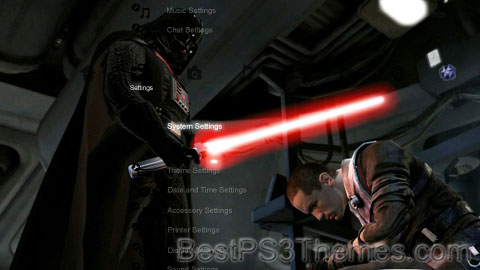
(7 backgrounds)
Texas Chainsaw Massacre
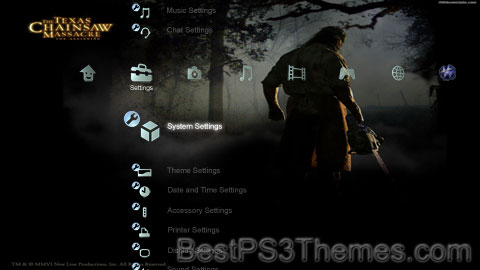
(2 backgrounds)
Banksy
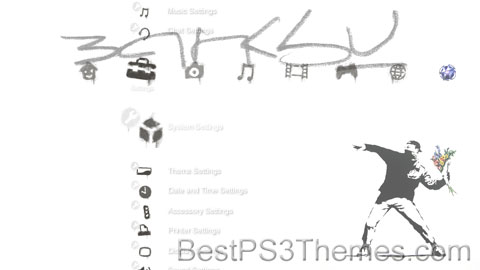
(1 background)

Born Known for Street art Website Identity[edit]
Career[edit]
Early career (1990–2001)[edit]
Exhibitions (2002–2003)[edit]


£10 notes to Barely Legal (2004–2006)[edit]
Banksy effect (2006–2007)[edit]
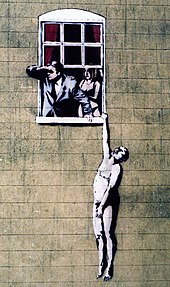


2008[edit]

The Cans Festival (2008)[edit]
2009[edit]

High End LucasFilm THX Silver

(1 background)
Copyright (c) 2007. Anoop Menon
p3textractor filename.p3t [destination path]Replace filename with the name of the p3t file, and replace [destination path] with the name of the folder you want the files to be extracted to. A destination path is not required. By default it will extract to extracted.filename.High End Blu Ray Silver

(1 background)
Copyright (c) 2007. Anoop Menon
p3textractor filename.p3t [destination path]Replace filename with the name of the p3t file, and replace [destination path] with the name of the folder you want the files to be extracted to. A destination path is not required. By default it will extract to extracted.filename.Planets #3

(2 backgrounds)
[[link]]s). However, do not replace these redirected links with a simpler link unless the page is updated for another reason (see WP:NOTBROKEN).Dr Who 2005 1
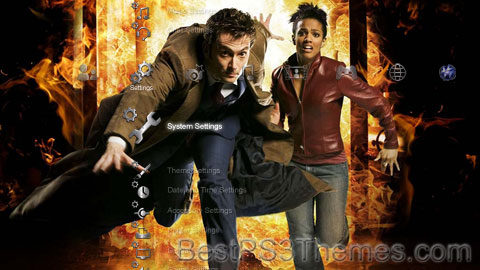
(13 backgrounds)
Copyright (c) 2007. Anoop Menon
p3textractor filename.p3t [destination path]Replace filename with the name of the p3t file, and replace [destination path] with the name of the folder you want the files to be extracted to. A destination path is not required. By default it will extract to extracted.filename.